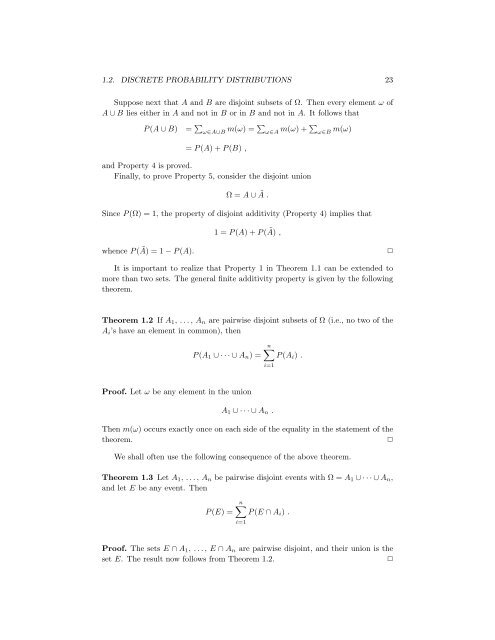Chapter 1 Discrete Probability Distributions - DIM
Chapter 1 Discrete Probability Distributions - DIM
Chapter 1 Discrete Probability Distributions - DIM
- No tags were found...
Create successful ePaper yourself
Turn your PDF publications into a flip-book with our unique Google optimized e-Paper software.
1.2. DISCRETE PROBABILITY DISTRIBUTIONS 23Suppose next that A and B are disjoint subsets of Ω. Then every element ω ofA ∪ B lies either in A and not in B or in B and not in A. It follows thatP (A ∪ B)= ∑ ω∈A∪B m(ω)=∑ ω∈A m(ω)+∑ ω∈B m(ω)=P(A)+P(B),and Property 4 is proved.Finally, to prove Property 5, consider the disjoint unionΩ=A∪Ã.Since P (Ω) = 1, the property of disjoint additivity (Property 4) implies that1=P(A)+P(Ã),whence P (Ã) =1−P(A).✷It is important to realize that Property 1 in Theorem 1.1 can be extended tomore than two sets. The general finite additivity property is given by the followingtheorem.Theorem 1.2 If A 1 , ..., A n are pairwise disjoint subsets of Ω (i.e., no two of theA i ’s have an element in common), thenP (A 1 ∪···∪A n )=n∑P (A i ) .i=1Proof. Let ω be any element in the unionA 1 ∪···∪A n .Then m(ω) occurs exactly once on each side of the equality in the statement of thetheorem.✷We shall often use the following consequence of the above theorem.Theorem 1.3 Let A 1 , ..., A n be pairwise disjoint events with Ω = A 1 ∪···∪A n ,and let E be any event. ThenP (E) =n∑P (E ∩ A i ) .i=1Proof. The sets E ∩ A 1 , ..., E ∩A n are pairwise disjoint, and their union is theset E. The result now follows from Theorem 1.2.✷
















